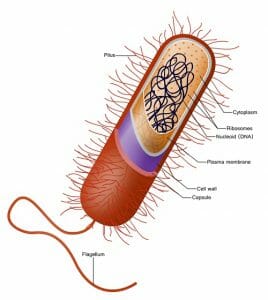Monera Definition
Monera is a kingdom in biology that comprises prokaryotes, which are single-celled organism that have no true nucleus. Monera is the most ancient group of organisms on earth, as well as the most numerous. In this kingdom, the organisms have naked DNA that forms a clump called the nucleoid, as shown below, while organisms in all other kingdoms have DNA enclosed in a nucleus. Since monerans are prokaryotes, such as bacteria, they have no membrane-bound organelles. They are also microscopic and usually live in moist environments. For example, we can find monerans within bodies of animals and plants, and in hot springs. Note that the term Monera is no longer used by many scientists, because they have found that the two groups that make up this kingdom, archaea and bacteria, aren’t as closely related as once thought. Rather, archaea are closer to eukaryotes than they are to bacteria.
Characteristics of Monerans
Some monerans are autotrophic, making their own food through either chemosynthesis, like nitrifying bacteria in the nitrogen cycle, or through photosynthesis, like purple sulfur bacteria. Others are heterotrophic, either existing as saprophytic decomposers that feed on dead organic matter found in the soil, or as parasitic bacteria that acquire food from a living host, usually causing it harm in the process.
Organisms in the Monera kingdom can have different means of mobility, such as movement by using the flagella, as in the diagram above, to propel themselves through liquids, axial filaments to rotate, or by secreting slime to glide.
Most organisms in the Monera kingdom reproduce asexually through binary fission, which does not allow for much genetic diversity, since each daughter cell produced receives genetic information that is identical to the parent’s.
Certain organisms in the Monera kingdom can surround themselves by a capsule as a means of defense from adverse conditions and threats, such as phagocytosis by white blood cells, and desiccation. The cell becomes coated and partially dehydrated, turning into an endospore, which a dormant phase. When conditions become favorable again, the endospore then returns to being an active cell.
Subkingdoms of Monera
Eubacteria
“Eu-“ as a prefix means “true”, so eubacteria is the subkingdom that includes the typical bacteria most of us are familiar with, such as E. coli.
Archeabacteria
Includes extremophiles that can tolerate harsh environments, such as high temperatures, high acidity, and the absence of oxygen. These organisms include thermophiles, or heat-loving organisms that can exist in places like volcanic vents; methanogens, which can exist in anoxic environments and produce methane gas as a metabolic byproduct; and halophiles, or salt-loving organisms that can exist in places where salinity levels are incredibly high.
Cyanobacteria
Cyanobacteria, or blue-green algae, are photosynthetic bacteria. Their cells contain pigments like chlorophyll, carotenoids, and phycobilins. Cyanobacteria are aquatic in nature and were once a part of the kingdom Plantae, but scientist have since discovered that they are prokaryotes. Being photosynthetic organisms, they are important producers of oxygen, though some of them produce neurotoxins that can harm aquatic life.
How Monerans Benefit Other Organisms
Bacteria enrich soil, and are very important in the nitrogen cycle, which is essential for plants survival. They are also useful to us in the way that they are important in producing some foods like cheese and vinegar, and used in the production of some antibiotics.
Methanogens also play a significant role in our lives, as they are used in the treatment of sewage. Finally, archaerbacteria as a whole group supports ecosystems in habitats with extreme conditions, since many organisms rely on them as a source of food.
Related Biology Terms
- Endosymbiont – An organism that exists within the cells or the body of another organism, the host.
- Eukaryotes – Organisms whose cells contain a nucleus that houses their genetic information.
- Genus – A taxonomic position in the classification of organisms that is found above Species and below Family.
- Nucleolus – A small structure where ribosome assembly occurs within a nucleus.
Quiz
1. What kinds of organisms does kingdom Monera consist of?
A. Archaea
B. Plants
C. Prokaryotes
D. Eukaryotes
2. Which of the following includes organisms that can tolerate extreme pH levels?
A. Archaebacteria
B. Eubacteria
C. Cyanobacteria
D. Fungi
3. Which of the following is never found in bacteria?
A. Flagella
B. Mitochondria
C. DNA
D. Cell membrane
4. Why was it first thought that cyanobacteria belong to the kingdom Plantae?
A. Because they are green in color
B. Because they are photosynthetic
C. Because they produce flowers
D. Because they don’t have a nucleus
Monera

No comments:
Post a Comment